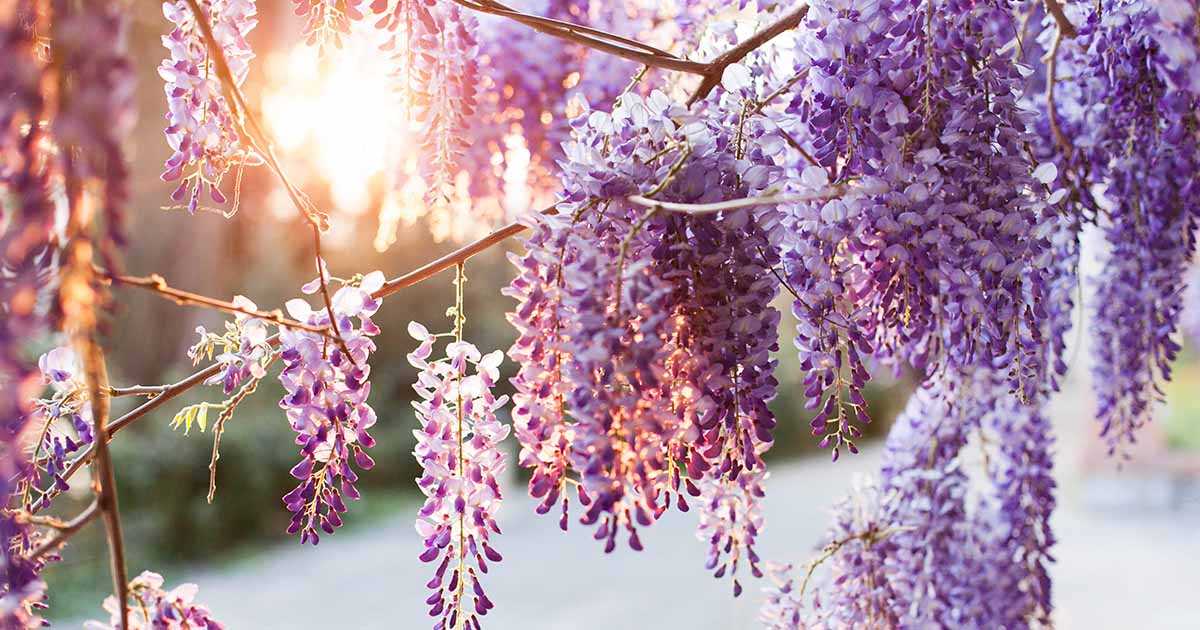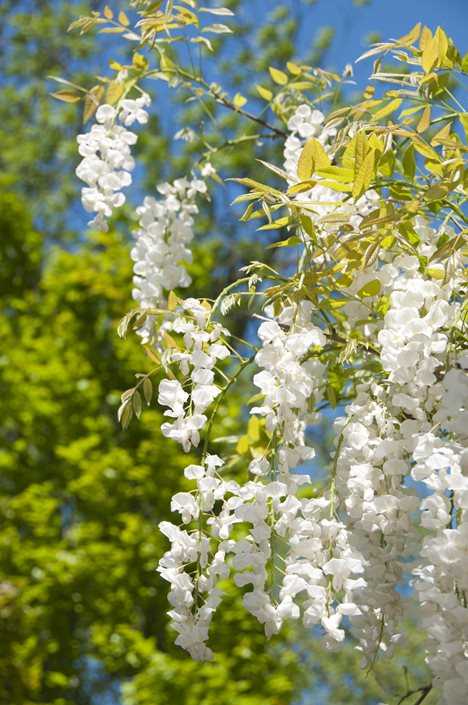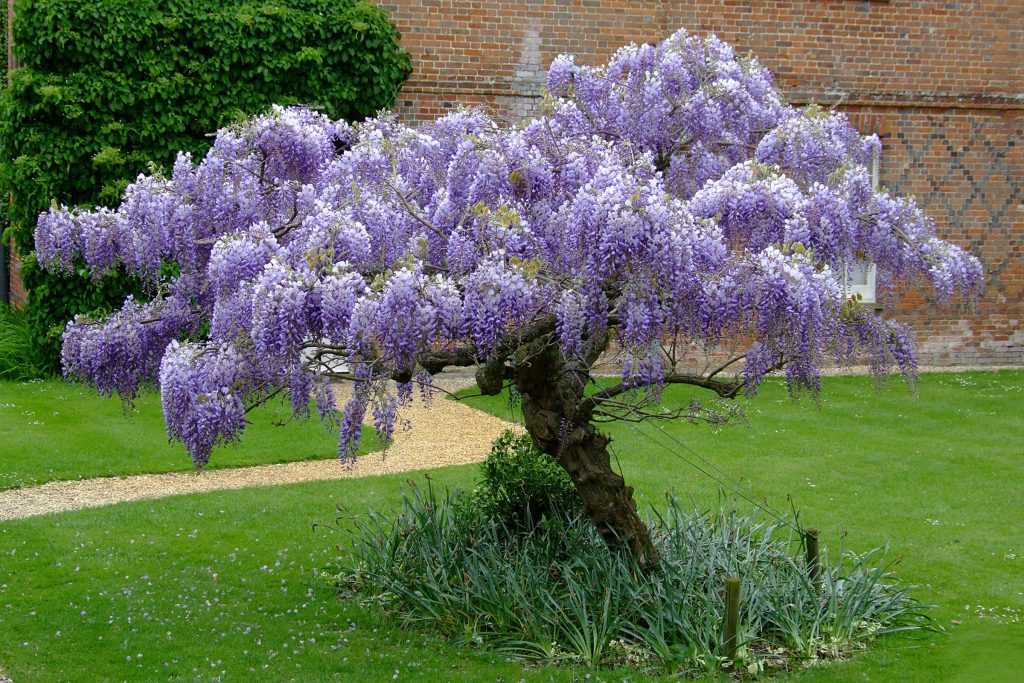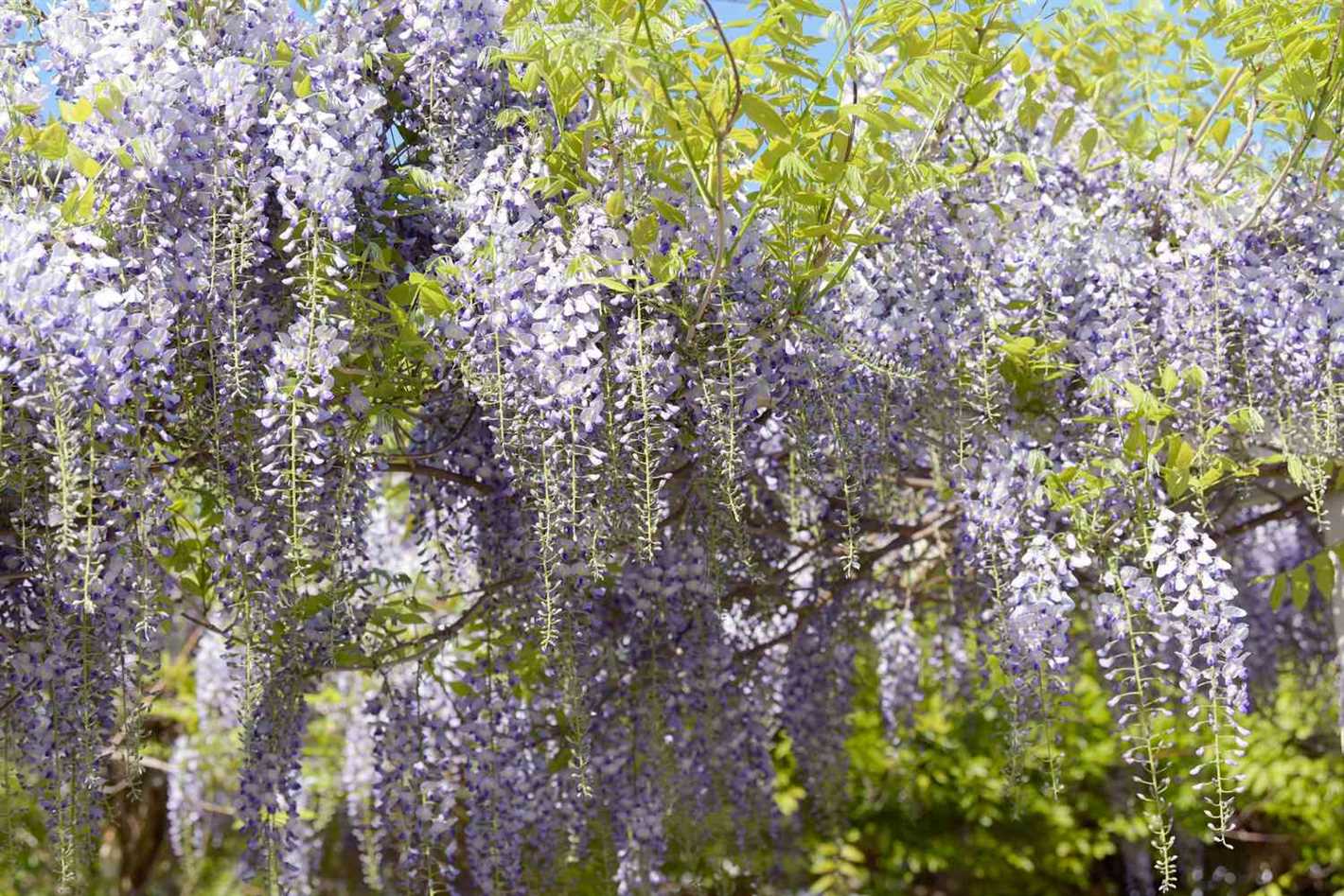- Growing Wisteria in the Garden
- Choosing the right location
- Planting wisteria
- Pruning wisteria
- Supporting wisteria
- Watering and fertilizing wisteria
- Common problems and pests
- Enjoying the beautiful blooms
- Types of Wisteria
- 1. Chinese Wisteria (Wisteria sinensis)
- 2. Japanese Wisteria (Wisteria floribunda)
- 3. American Wisteria (Wisteria frutescens)
- 4. Kentucky Wisteria (Wisteria macrostachya)
- 5. Silky Wisteria (Wisteria brachybotrys)
- Wisteria Varieties
- Japanese Wisteria (Wisteria floribunda)
- Chinese Wisteria (Wisteria sinensis)
- American Wisteria (Wisteria frutescens)
- Silk Tree (Wisteria sinensis ‘Alba’)
- Black Dragon (Wisteria sinensis ‘Black Dragon’)
- Cultivar Varieties
- Choosing the Right Wisteria
- Climate
- Size
- Growth Habit
- Flower Color
- Maintenance
- Planting and Caring for Wisteria
- Planting Wisteria
- Caring for Wisteria
- Conclusion
- Common Problems and Solutions
- 1. Lack of Blooms
- 2. Overgrowth and Invasive Behavior
- 3. Pests and Diseases
- 4. Failure to Attach or Climb
- Questions and Answers:
- How do I grow wisteria in my garden?
- What are the different types of wisteria?
- What are the best varieties of wisteria to grow?
- How long does it take for wisteria to bloom?
- When is the best time to prune wisteria?
- Videos: Another Wisteria video – but this one is really good.

If you’re looking for a beautiful and fragrant addition to your garden, look no further than wisteria. With its cascading blooms and delicate scent, wisteria is a favorite among gardeners around the world. In this article, we’ll explore everything you need to know about growing wisteria in your garden, including the different types and varieties available.
Known for its stunning purple flowers, wisteria is a vine that can add a touch of elegance to any outdoor space. Whether you want to create a romantic arboretum or add some color to a pergola, wisteria is a versatile plant that can be trained to grow in various ways.
There are several different types of wisteria to choose from, including the American, Chinese, and Japanese varieties. Each type has its own unique characteristics and requirements, so it’s important to do your research before planting. From determining the right type for your climate to providing the necessary support and care, understanding the specific needs of your chosen wisteria variety is key to success.
So whether you’re a seasoned gardener or just starting out, this article will provide you with all the information you need to successfully grow wisteria in your garden. From selecting the right type and variety to providing the proper care and support, you’ll be able to enjoy the beauty and fragrance of these stunning flowering vines in no time.
Growing Wisteria in the Garden
Wisteria is a beautiful flowering vine that can add charm and elegance to any garden. Here are some tips on how to grow wisteria in your garden:
Choosing the right location
Wisteria grows best in full sun, so it is important to choose a location that receives at least 6 hours of direct sunlight each day. The soil should be well-drained and fertile.
Planting wisteria
When planting wisteria, dig a hole that is twice as wide and deep as the root ball. Place the plant in the hole and backfill with soil, firming it gently around the roots. Water thoroughly after planting.
Pruning wisteria


Pruning is essential to maintain the shape and health of wisteria vines. It is best to prune wisteria twice a year, once in late winter or early spring, and again in mid-summer. Remove any dead or damaged branches, as well as any suckers that may appear.
Supporting wisteria
Wisteria is a vigorous vine that needs strong support. It can be trained to grow on a trellis, pergola, or arbor. Make sure the support structure is sturdy enough to withstand the weight of the vine.
Watering and fertilizing wisteria
Wisteria needs regular watering, especially during dry periods. Water deeply, but make sure the soil is well-drained to prevent root rot. Fertilize wisteria in early spring and again in late summer with a balanced fertilizer.
Common problems and pests
Wisteria can be prone to certain problems and pests, such as aphids, spider mites, and powdery mildew. Regular inspection of the plant and prompt action can help prevent and control these issues.
Enjoying the beautiful blooms


With proper care and maintenance, wisteria will reward you with stunning clusters of fragrant flowers in shades of purple, lavender, pink, or white. Enjoy the beautiful blooms and the sweet fragrance that fills the air!
Types of Wisteria
There are several different types of wisteria that can be found in gardens around the world. Each type has its own unique characteristics, including flower color, growth pattern, and hardiness.
1. Chinese Wisteria (Wisteria sinensis)
The Chinese wisteria is one of the most popular and common types of wisteria. It features long clusters of fragrant flowers that can be purple, lavender, or white. This wisteria has a rapid growth rate and can reach heights of up to 30 feet.
2. Japanese Wisteria (Wisteria floribunda)
The Japanese wisteria is another popular variety known for its stunning floral display. It produces long, pendulous clusters of flowers that can be purple, pink, or white. The Japanese wisteria is slightly less vigorous than the Chinese wisteria and can reach heights of around 25 feet.
3. American Wisteria (Wisteria frutescens)
The American wisteria is a native variety found in the southeastern United States. It has similar growth habits to the Chinese and Japanese wisteria but has smaller flower clusters. The flowers of the American wisteria are typically pale purple or white.
4. Kentucky Wisteria (Wisteria macrostachya)
The Kentucky wisteria is a hardy variety that is native to the central and southeastern United States. It produces large clusters of flowers that can range in color from white to pale blue. This wisteria typically blooms later in the season and is known for its fragrance.
5. Silky Wisteria (Wisteria brachybotrys)
The silky wisteria is a lesser-known variety that hails from Japan. It features shorter flower clusters that are densely packed with colorful blooms. The silky wisteria comes in a range of colors, including purple, white, and pink.
These are just a few examples of the many types of wisteria that can be found in gardens worldwide. Each variety has its own unique beauty and characteristics, making wisteria a versatile and popular choice for gardeners.
Wisteria Varieties
Wisteria is a beautiful flowering plant that belongs to the pea family. It is known for its clusters of fragrant, pendulous flowers that bloom in shades of purple, white, pink, and blue. There are several different varieties of wisteria, each with its own unique characteristics.
Japanese Wisteria (Wisteria floribunda)
The Japanese wisteria is a popular choice for many gardeners due to its stunning display of flowers. It is known for its long, hanging clusters of blossoms that can reach up to 18 inches in length. The flowers are typically a deep shade of purple, but some varieties also produce white or pink blooms. Japanese wisteria is a vigorous grower and can reach heights of 30 feet or more.
Chinese Wisteria (Wisteria sinensis)
The Chinese wisteria is another common type of wisteria that is highly prized for its beautiful flowers. It has similar characteristics to the Japanese wisteria, with long cascades of blooms that range in color from white to lavender-blue. Chinese wisteria is a fast-growing vine that can reach significant heights if left unpruned. This variety is often seen covering pergolas and arbors, providing shade and a breathtaking floral display.
American Wisteria (Wisteria frutescens)
American wisteria is native to the southeastern United States and is a more petite variety compared to its Asian counterparts. Its flowers are smaller, but they still create a stunning display when they bloom in spring. American wisteria typically produces clusters of pale violet or lilac-colored blossoms. This variety is well-suited for smaller gardens or as a ground cover.
Silk Tree (Wisteria sinensis ‘Alba’)
The Silk Tree wisteria is a cultivar of the Chinese wisteria and is known for its pure white flowers. It is a less vigorous variety, making it a popular choice for smaller gardens. The Silk Tree wisteria can be trained to grow as a tree or a vine, and its white blossoms provide a striking contrast against its dark green foliage.
Black Dragon (Wisteria sinensis ‘Black Dragon’)
The Black Dragon wisteria is a unique variety that is prized for its dark, almost black, purple flowers. This cultivar produces shorter flower clusters compared to other wisteria varieties but makes up for it with its intense color. The Black Dragon wisteria is a particularly eye-catching choice for gardens where a dramatic focal point is desired.
Cultivar Varieties
Aside from the main wisteria varieties mentioned above, there are also numerous cultivar varieties available. These cultivars may have unique flower colors, such as pink or blue, or different growth habits. It is worth exploring the different cultivar options to find the perfect wisteria variety that suits your garden and personal preferences.
| Variety | Flower Color | Growth Habit |
|---|---|---|
| Amethyst Falls | Purple | Vine |
| Blue Moon | Blue | Vine |
| Caroline | White | Vine |
| Pink Ice | Pink | Vine |
| Domino | Varying shades of purple and white | Tree |
These are just a few examples of the many wisteria varieties available. Whether you prefer the classic blooms of the Japanese and Chinese varieties or the unique colors and growth habits of the cultivars, there is sure to be a wisteria variety that will enhance your garden with its beauty and fragrance.
Choosing the Right Wisteria
When choosing a wisteria plant for your garden, there are several factors to consider to ensure you select the right variety. Here are some tips to help you choose the right wisteria:
Climate
Wisteria plants thrive in temperate climates, so it is important to choose a variety that is suitable for your specific region. Some wisteria varieties are better suited for colder climates, while others fare better in warmer climates. Do some research to find out which varieties are recommended for your area.
Size
Consider the size of the area where you plan to plant the wisteria. Wisteria plants can grow quite large, so make sure you have enough space to accommodate their growth. Some varieties can reach up to 30 feet in length, so keep this in mind when selecting a wisteria plant.
Growth Habit
Wisteria plants have different growth habits, and it is important to choose a variety that suits your needs. Some varieties have a twining growth habit, while others have a trailing or climbing growth habit. Consider how you want the wisteria to grow and choose a variety accordingly.
Flower Color
Wisteria plants produce beautiful flowers in a variety of colors, including purple, white, pink, and blue. Consider the color scheme of your garden and choose a wisteria variety that complements it. You may also want to consider the scent of the flowers, as some varieties have a stronger fragrance than others.
Maintenance
Different wisteria varieties have different maintenance needs, so be sure to choose a variety that fits your gardening style. Some varieties require more pruning and support than others. If you prefer a low-maintenance plant, look for a wisteria variety that is known for its easy-care nature.
| Variety | Climate | Size | Growth Habit | Flower Color | Maintenance |
|---|---|---|---|---|---|
| Amethyst Falls | Hardy to USDA zone 5 | Vine can reach 30 ft | Twining | Blue-violet | Low |
| Black Dragon | Hardy to USDA zone 5 | Height of 20 ft | Twining | Deep purple | Moderate |
| Caroline | Hardy to USDA zone 4 | Height of 25 ft | Twining | Light blue | Moderate |
| Longissima Alba | Hardy to USDA zone 5 | Vine can reach 25 ft | Climbing | White | Low |
| Silky Wisteria | Hardy to USDA zone 4 | Height of 20 ft | Twining | Lavender-purple | Low |
By considering these factors and doing some research on different wisteria varieties, you can choose the right wisteria plant for your garden. Whether you prefer a small and low-maintenance variety or a large showstopper, there is a wisteria plant that will suit your needs and bring beauty to your garden.
Planting and Caring for Wisteria
Planting Wisteria
To successfully grow wisteria in your garden, follow these planting guidelines:
- Select a suitable location: Wisteria thrives in full sun, so choose a spot in your garden that receives at least 6 hours of direct sunlight each day. The soil should be well-drained, fertile, and rich in organic matter.
- Prepare the soil: Before planting, amend the soil with compost or well-rotted manure to improve its fertility and drainage. Remove any weeds or grass from the planting area.
- Dig a hole: Dig a hole that is at least twice as wide and as deep as the root ball of your wisteria plant.
- Place the plant: Carefully place the wisteria plant in the hole, ensuring that the top of the root ball is level with or slightly above the soil surface.
- Backfill the hole: Fill the hole with soil, firming it gently around the roots to eliminate any air pockets. Water the plant thoroughly.
- Provide support: As wisteria is a climbing vine, it needs a sturdy support structure. Install a trellis, arbor, or pergola near the plant to provide support.
Caring for Wisteria


Once your wisteria is planted, it requires regular care to ensure its health and proper growth:
- Watering: The first year after planting, water your wisteria deeply once a week, providing enough water to keep the soil consistently moist. In subsequent years, water during dry periods to prevent the soil from drying out completely.
- Fertilizing: In early spring, apply a balanced fertilizer to promote healthy growth. Follow the package instructions for the correct dosage and application method.
- Pruning: Proper pruning is essential for controlling the size and promoting flower production. Prune wisteria twice a year: once in early spring to remove dead or damaged wood, and once in mid-summer to control growth and encourage flowering.
- Mulching: Apply a 2-4 inch layer of mulch around the base of the plant to conserve moisture, suppress weeds, and moderate soil temperature.
- Pest and disease control: Monitor your wisteria for pest infestations and signs of disease. Treat any issues promptly using appropriate organic or chemical controls.
Conclusion
By following these planting and care guidelines, you can enjoy the beauty and fragrance of wisteria in your garden. With proper care, this stunning vine will reward you with spectacular blooms year after year.
Common Problems and Solutions
1. Lack of Blooms


If your wisteria is not blooming, it may be due to several factors:
- Insufficient sunlight: Wisteria plants require full sun to bloom profusely. Ensure that your plant is getting at least 6-8 hours of direct sunlight per day.
- Improper pruning: Wisteria blooms on old wood, so if you are pruning in late winter or early spring, you may be cutting off the flower buds. Prune wisteria immediately after flowering to encourage future blooms.
- Nitrogen-rich soil: High levels of nitrogen in the soil can promote foliage growth at the expense of flowers. Avoid fertilizers with high nitrogen content and instead use a balanced fertilizer with a higher phosphorus and potassium content.
2. Overgrowth and Invasive Behavior
Wisterias are vigorous climbers and can quickly take over a garden if not properly controlled. Here are some solutions to prevent overgrowth:
- Regular pruning: Prune wisteria regularly to control its growth and shape. Remove any excessive growth and keep the plant within the desired boundaries.
- Root pruning: If your wisteria is spreading too aggressively through underground runners, consider root pruning to restrict its growth. Dig a trench around the wisteria and cut through the root system, removing any unwanted shoots.
- Use of support structures: Provide a strong and sturdy support structure for your wisteria to climb on. This will prevent it from spreading to unwanted areas and keep its growth contained.
3. Pests and Diseases
While wisterias are generally resilient plants, they can still be susceptible to certain pests and diseases. Here are some common problems and solutions:
| Problem | Solution |
|---|---|
| Aphids | Use insecticidal soap or neem oil to control aphid infestations. Regularly inspect the plant and remove any affected leaves or shoots. |
| Powdery Mildew | Ensure proper air circulation around the plant by pruning and thinning it. Treat powdery mildew with a fungicide specifically formulated for this disease. |
| Japanese Beetles | Handpick the beetles from the plant and drop them into a bucket of soapy water. Alternatively, use insecticides labeled for Japanese beetle control. |
| Root Rot | Avoid overwatering and ensure proper drainage. If root rot is present, consider removing and replacing the affected plant parts. |
| Leaf Spot | Regularly inspect the plant for leaf spot symptoms and remove any affected leaves. Apply a fungicide if necessary. |
4. Failure to Attach or Climb
If your wisteria is not attaching or climbing properly, you can try the following solutions:
- Training: Guide the young tendrils of the wisteria onto the support structure by gently tying them with twine or plant ties.
- Providing a sturdy support: Make sure your support structure is strong enough to hold the weight of the wisteria. Use sturdy wires, trellises, or pergolas for this purpose.
- Encouraging growth: Ensure that the wisteria receives adequate sunlight, water, and nutrients to promote healthy growth and climbing behavior.
Questions and Answers:
How do I grow wisteria in my garden?
To grow wisteria in your garden, you will need to select a suitable location with well-drained soil and full sun. Plant the wisteria in a hole that is twice as wide and deep as the root ball, and then backfill with soil. Water the plant well after planting, and continue to water regularly during the growing season. Train the wisteria to grow on a support structure, such as a trellis or pergola, and prune it annually to maintain its shape and promote blooming.
What are the different types of wisteria?
There are several different types of wisteria, including Wisteria sinensis, Wisteria floribunda, and Wisteria frutescens. Wisteria sinensis is the most commonly grown type and has long, hanging clusters of fragrant flowers. Wisteria floribunda, also known as Japanese wisteria, has shorter flowers but they are more numerous and showy. Wisteria frutescens, or American wisteria, has shorter flowers that are pale purple or white. Each type has its own unique characteristics and growing requirements.
What are the best varieties of wisteria to grow?
Some of the best varieties of wisteria to grow include ‘Alba’, which has white flowers, ‘Prolific’, which has abundant flowers, and ‘Amethyst Falls’, a dwarf variety that is well-suited for smaller gardens. Other popular varieties include ‘Black Dragon’, ‘Blue Moon’, and ‘Cooke’s Purple’.
How long does it take for wisteria to bloom?
Wisteria typically takes about 3 to 5 years to bloom after it has been planted. However, this can vary depending on various factors such as the age and size of the plant, growing conditions, and proper care. It is important to be patient and provide the necessary care for the wisteria to encourage blooming.
When is the best time to prune wisteria?
The best time to prune wisteria is in late winter or early spring, while the plant is still dormant. This is typically before new growth starts to emerge. Pruning during this time allows you to shape the plant and remove any dead or diseased growth. It is important to prune wisteria regularly to maintain its shape and promote blooming.







